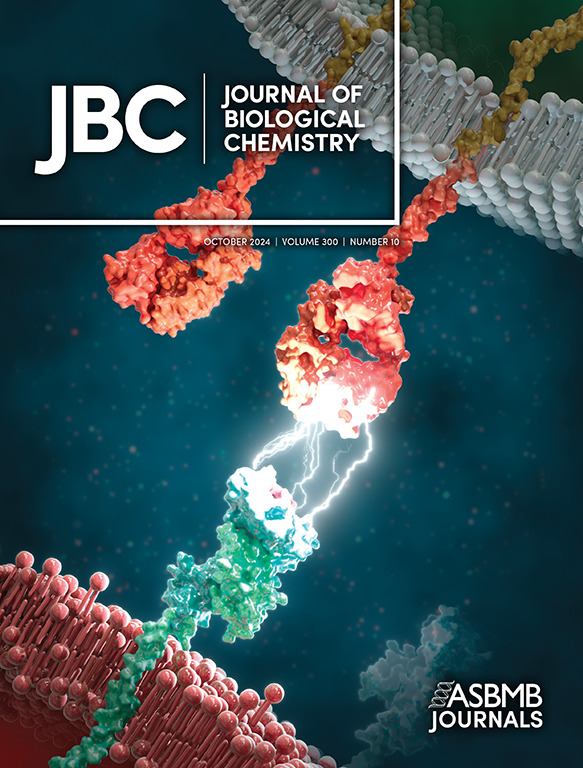RNA解旋酶MOV10的功能研究及其与无义介导的mRNA衰变相关因子的相互作用。
IF 4
2区 生物学
Q2 BIOCHEMISTRY & MOLECULAR BIOLOGY
引用次数: 0
摘要
RNA解旋酶Moloney白血病病毒10 (MOV10)参与多种RNA加工途径,包括RNA沉默、防御病毒RNA和无义介导的mRNA衰变(NMD)。MOV10是超家族1 (SF1)解旋酶upf1家族的一员,像它的原型成员一样,解绕带有5'-单链悬垂的RNA双链。对MOV10和UPF1的序列比较发现,它们的RecA结构域之间存在显著的一致性,而解旋酶核心之前的n端结构域之间存在相当大的差异。利用体外生化方法,我们发现MOV10的n端结构域(NTD)在功能上不同于UPF1的CH结构域,无论是在其对催化活性的影响还是在其介导的蛋白-蛋白相互作用方面。MOV10通过其n端调控结构域参与NMD因子UPF2,但结合的区域与UPF1-CH结构域不同。我们认为,由MOV10-NTD介导的相互作用决定了其定位于细胞质RNA凝聚物,如p体和应力颗粒。这与UPF1不同,UPF1的定位似乎是由其与RNA的相互作用驱动的。综上所述,我们的工作提出了MOV10在NMD中的招募和参与的机制模型,其中它被提议作为UPF1的RNA清除因子。本文章由计算机程序翻译,如有差异,请以英文原文为准。
Functional investigation of the RNA helicase MOV10 with respect to its interplay with factors involved in nonsense-mediated mRNA decay.
The RNA helicase Moloney leukemia virus 10 (MOV10) is involved in several RNA processing pathways, including RNA silencing, defence against viral RNA and nonsense-mediated mRNA decay (NMD). MOV10 is a member of the UPF1-family of superfamily 1 (SF1) helicases and like its prototype member, unwinds RNA duplexes bearing a 5'-single-stranded overhang. Sequence comparisons of MOV10 and UPF1 revealed significant identity between their RecA domains and considerable divergence between the N-terminal domains preceding the helicase core. Using an in vitro biochemical approach, we show that the N-terminal domain (NTD) of MOV10 is functionally distinct from the CH domain of UPF1, both in terms of its impact on catalytic activity and the protein-protein interactions it mediates. MOV10 engages the NMD factor UPF2 via its N-terminal regulatory domain but binds a different region than the UPF1-CH domain. We propose that the interactions mediated by the MOV10-NTD dictate its localization to cytoplasmic RNA condensates such as P-bodies and stress granules. This is distinct from UPF1, whose localization appears to be driven by its interaction with RNA. Taken together, our work presents a mechanistic model for the recruitment and involvement of MOV10 in NMD, where it was proposed to act as an RNA clearance factor for UPF1.
求助全文
通过发布文献求助,成功后即可免费获取论文全文。
去求助
来源期刊

Journal of Biological Chemistry
Biochemistry, Genetics and Molecular Biology-Biochemistry
自引率
4.20%
发文量
1233
期刊介绍:
The Journal of Biological Chemistry welcomes high-quality science that seeks to elucidate the molecular and cellular basis of biological processes. Papers published in JBC can therefore fall under the umbrellas of not only biological chemistry, chemical biology, or biochemistry, but also allied disciplines such as biophysics, systems biology, RNA biology, immunology, microbiology, neurobiology, epigenetics, computational biology, ’omics, and many more. The outcome of our focus on papers that contribute novel and important mechanistic insights, rather than on a particular topic area, is that JBC is truly a melting pot for scientists across disciplines. In addition, JBC welcomes papers that describe methods that will help scientists push their biochemical inquiries forward and resources that will be of use to the research community.
 求助内容:
求助内容: 应助结果提醒方式:
应助结果提醒方式:


